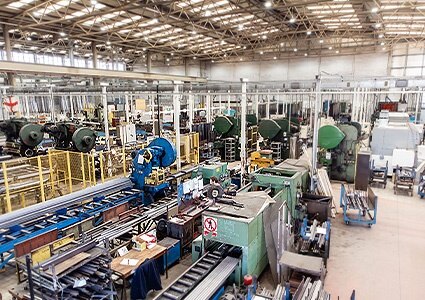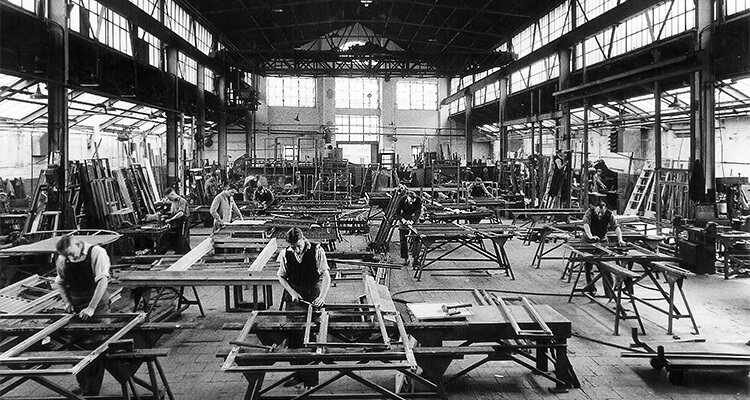Discover the historic journey of sustainable window producer Crittall Windows
Founded over 170 years ago, Crittall Windows Ltd (Crittall) is the world’s leading and most well-established manufacturer of steel windows and doors. Leveraging its cutting-edge manufacturing and design expertise, the company remains unrivalled in its engineering and production capabilities. Notably, Crittall is the manufacturer of choice for historic and refurbishment projects, due to its proficiency in replicating and replacing architecturally significant metal windows. Today, Crittall manufactures and supplies its iconic steel products for contemporary, commercial, and residential new build projects designed by some of today’s foremost architects and works alongside architects and contractors from across the globe. Darren Joyce, Production Director, delves into the company’s century-old history.
“Crittall was established as a small metal hardware company in 1849. At that time, mild steel had just been invented, beginning to replace cast iron in window

manufacturing. Initially based in Braintree, Crittall remained a relatively small business with only a few employees until the late 1800s. At this point, the invention of the Bessemer furnace enabled the production of mild steel bars, favored by architects for designing large expanses of glass. Around 1909, the steel window industry boomed as the new material gained popularity, with several companies experimenting with it – though none to the same extent as the Crittall family. By the late 1920s, the company had expanded from between 30 and 40 employees to over 20,000 across 14 factories worldwide. Until 1948, our production methods relied on limited labor-intensive technologies, involving extremely heavy machinery and base materials. Following World War II, the blitz destroyed many houses, leading to Crittall’s involvement in government housing rebuild schemes. During this period, we shipped thousands of our standard metal windows per week, utilizing our own railway station in Witham, adjacent to our factory, which connected directly to the main line.
“With the widespread use of aluminum in manufacturing in the late 1940s, much of our trade began to dissipate between then and the mid-1960s. Notably, Crittall continued to work with aluminum until the 1990s. Concerns about steel rusting arose in 1948, prompting us to alter our process by hot dip galvanizing our products in molten zinc for rustproofing. Whilst this significantly changed our manufacturing approach, the machinery and process remained the same until the 1970s when we introduced powder coating within our polyester powder coating plant. Finally, in the 1990s, Crittall recognized the need to employ manufacturing techniques that were more waste and energy efficient,” he highlights.
Having enhanced its carbon reduction strategies since then, Crittall has evolved into a sustainability-focused corporation boasting an ISO14001 certification. “Nowadays, Crittall continues to generate substantial profits, empowering us to invest in conducting our operations in a more environmentally friendly manner. Indeed, over the past three-to-four years, sustainability has been a key focus for us. The energy crisis left us with no choice but to recruit energy consultants. Together, we performed a thorough assessment of our business, comprehensively analyzing our gas, water, and electricity usage to supplement previous energy saving initiatives including installing over 1000 solar panels on our office roof and switching to LED lighting throughout the building. In addition, to optimize our gas usage, we implemented several initiatives, including replacing our powder coating curing burners with more energy efficient ones. Furthermore, after having our carbon footprint assessed in March, we gained insight into areas we need to improve. The assessment revealed electricity usage and personnel travel as the two major factors Crittall still needs to address. Although there are more ways we can improve our electricity efficiency, there are limitations regarding our personnel’s fuel consumption, as they cannot manufacture our products from home. However, I believe we offset this by making products that are intrinsically eco-friendly,” he informs.
 Expanding further on this point, Darren sheds light on the sustainability of Crittall’s products, which is a current focus of the R&D team. “Derived from 100 percent recycled materials, our steel is not only highly sustainable, but can also be recycled once it reaches the end of its century-long lifespan. Additionally, steel offers a small profile compared to PVCu, aluminum or timber, allowing more natural daylight and heat to permeate through windows. Consequently, buildings become more energy efficient, reducing their need for heating. Lately, we have started developing even more sustainable products. Specifically, we introduced a range of thermally broken steel products, which has gained significant traction over the last few years. In fact, this range is becoming an increasingly larger part of our product portfolio. Crittall has also started advertising several innovative products,” he enlightens.
Expanding further on this point, Darren sheds light on the sustainability of Crittall’s products, which is a current focus of the R&D team. “Derived from 100 percent recycled materials, our steel is not only highly sustainable, but can also be recycled once it reaches the end of its century-long lifespan. Additionally, steel offers a small profile compared to PVCu, aluminum or timber, allowing more natural daylight and heat to permeate through windows. Consequently, buildings become more energy efficient, reducing their need for heating. Lately, we have started developing even more sustainable products. Specifically, we introduced a range of thermally broken steel products, which has gained significant traction over the last few years. In fact, this range is becoming an increasingly larger part of our product portfolio. Crittall has also started advertising several innovative products,” he enlightens.
Crittall is prepared for its next phase of growth. “Our goal for the next five years is to increase our market share. To achieve this, we will intensify our R&D efforts and expand our range of thermally broken products to further establish ourselves in that sector. Most importantly, Crittall’s key focus will be on enhancing its presence in the US market, where new small bar-welding companies have taken some of the market share despite our historical strong foothold. Although we’ve completed significant commercial and institutional projects in the US, we are looking to increase our share of the residential sector, with investment into compliancy with the country’s unique set of standards. In the long term, we aim to safeguard our brand name. Crittall is synonymous with steel windows, which has led to trademark battles as other companies sell products suspiciously like ours, albeit made of inferior quality materials, often dubbed ‘Crittall style’. Therefore, we seek to become the first port of call for Crittall windows,” he ends.
Through its enduring dedication and a well-planned growth strategy, Crittall is poised for success across its future endeavors.
